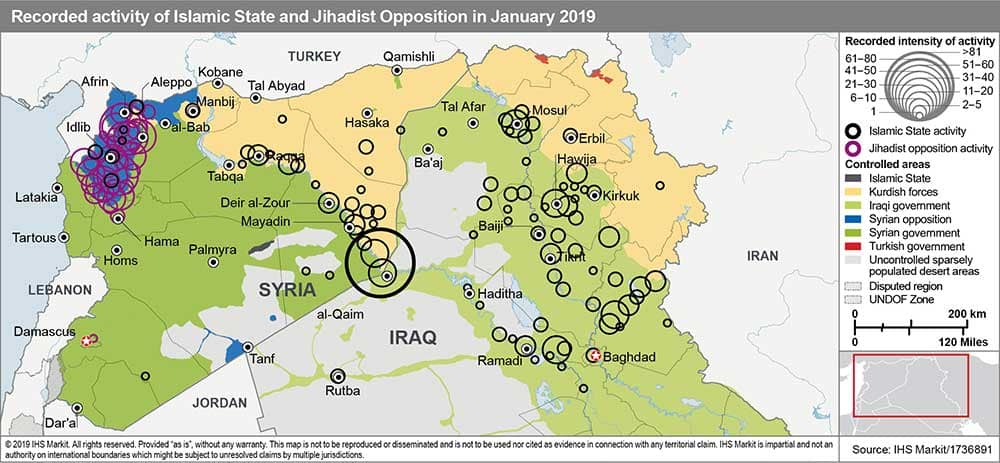Customer Logins
Obtain the data you need to make the most informed decisions by accessing our extensive portfolio of information, analytics, and expertise. Sign in to the product or service center of your choice.
Customer Logins
BLOG
Feb 07, 2019
Islamic State to retain attack capability in Syria beyond loss of 'Caliphate'
Donald Trump's statement that the Islamic State is on the brink of collapse is true in terms of their territorial control. At the height of the so-called 'Caliphate' in late 2014, the group controlled an area of more than 90,800 km2, which is about the size of Portugal.
Now the Islamic State's territorial control has shrunk to a hand-full of small villages in the desert of eastern Syria, about 50 km2. We expect these to fall in the coming days or weeks.
.png)
The Islamic State has regrouped in Iraq since it was declared defeated by the Iraqi government in December 2017, and we are now seeing a resurgence in central Iraq. We expect the same thing to happen in Syria.
Thousands of Islamic State fighters and their families have already escaped what remains of the besieged 'Caliphate'. Some have surrendered and are being held in refugee camps in Syria, others are hiding out in the deserts on southern and eastern Syria and many have merged back into the Sunni tribal populations of eastern Syria, where they still enjoy a degree of popular sympathy.
A major challenge will be to decide what to do with the many foreigners, many of whom travelled from Europe to join the Islamic State in Syria, who are now being held in detention.
Islamic State militant cells remain active in the Sunni tribal areas along the Euphrates and Khabour rivers (see map below of Islamic State activity in January 2019, as recorded by IHS Markit), and are likely to continue their campaign of IED attacks against Kurdish security forces and their foreign backers.
The suicide IED attack which killed five US service personnel in Manbij on 16 January demonstrates that the Islamic State still retains sufficient intelligence penetration of, and capability to conduct sophisticated attacks in areas where the group has no territorial control.

{"items" : [
{"name":"share","enabled":true,"desc":"<strong>Share</strong>","mobdesc":"Share","options":[ {"name":"facebook","url":"https://www.facebook.com/sharer.php?u=http%3a%2f%2fprod.azure.ihsmarkit.com%2fmarketintelligence%2fen%2fmi%2fresearch-analysis%2fislamic-state-to-retain-attack-capability-in-syria.html","enabled":true},{"name":"twitter","url":"https://twitter.com/intent/tweet?url=http%3a%2f%2fprod.azure.ihsmarkit.com%2fmarketintelligence%2fen%2fmi%2fresearch-analysis%2fislamic-state-to-retain-attack-capability-in-syria.html&text=+Islamic+State+to+retain+attack+capability+in+Syria+beyond+loss+of+%27Caliphate%27+%7c+S%26P+Global+","enabled":true},{"name":"linkedin","url":"https://www.linkedin.com/sharing/share-offsite/?url=http%3a%2f%2fprod.azure.ihsmarkit.com%2fmarketintelligence%2fen%2fmi%2fresearch-analysis%2fislamic-state-to-retain-attack-capability-in-syria.html","enabled":true},{"name":"email","url":"?subject= Islamic State to retain attack capability in Syria beyond loss of 'Caliphate' | S&P Global &body=http%3a%2f%2fprod.azure.ihsmarkit.com%2fmarketintelligence%2fen%2fmi%2fresearch-analysis%2fislamic-state-to-retain-attack-capability-in-syria.html","enabled":true},{"name":"whatsapp","url":"https://api.whatsapp.com/send?text=+Islamic+State+to+retain+attack+capability+in+Syria+beyond+loss+of+%27Caliphate%27+%7c+S%26P+Global+ http%3a%2f%2fprod.azure.ihsmarkit.com%2fmarketintelligence%2fen%2fmi%2fresearch-analysis%2fislamic-state-to-retain-attack-capability-in-syria.html","enabled":true}]}, {"name":"rtt","enabled":true,"mobdesc":"Top"}
]}




